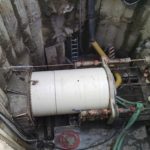- Company: Super Excavators Inc.
- Industry: Water/Wastewater
- Location: Cleveland, Ohio
- Expected Completion Date: December 31, 2016
- Project Website
The Dugway West Interceptor Relief Sewer (DWIRS) is a new 58 million dollar project that is constructed in the Glenville neighborhood of Cleveland Ohio. DWRIS is a major component of the first phase of the Northeast Ohio Regional Sewer District’s “Project Clean Lake” program. The project involves the installation of 14,000′ of 108″ to 24″ sanitary sewer pipe. It also included the first designed microtunnel curve in the Midwest region of the US. As part of project Clean Lake, the DWIRS portion is projected to capture and treat 110 million gallons of combined sewer overflows annually, thereby dramatically reducing raw sewage discharge into lake Erie.
What impact does this project have on America?
Clean water. As the Great Lakes hold one fifth of the fresh water in the world, we all care. 6 quadrillion gallons…
What interesting obstacles or unusual circumstances did you overcome to complete the project?
The project is located in the residential Glenville neighborhood on the East side of Cleveland. This is a very densely populated area of Cleveland which was originally built up in the early 1900’s. Super Excavators proposed a contractor designed curved microtunnel alignment that would save construction time, eliminate two access shafts, reduce the NEORSD’s long term workload and reduce the construction impact to the neighborhood. SEI built a 700′ long microtunnel run, starting out with a 140′ straight alignment, a 340′ -foot long curve on a 915′ radius then transitioned back to straight alignment at 480′ and finished with a 210′ long run. Total length was approximately 690′
What dangers and risks did you encounter, and describe any extraordinary methods used to keep workers safe?
Ground conditions through out the entire project alignment consisted of soft silts, clays, fill and shale bedrock with high ground water. All of the tunnel alignment paralleled the existing 12′ diameter Dugway culvert which was built in the early 1900’s.
How did you leverage new technologies to work faster and reduce waste?
The use of a VMT laser guidance system allowed the construction of the curve. This was the first use of a VMT system with an Akkerman microtunnel machine in the country.




